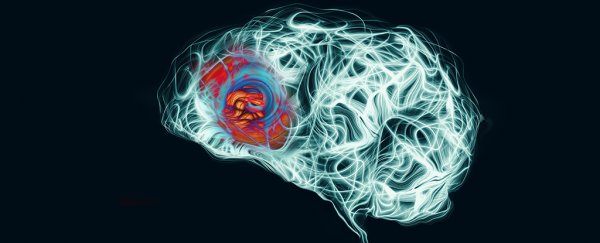Massaging key parts of the brain with a pulsating magnetic field can do wonders for some living with chronic depression. For others, it falls well short of promising a life without a debilitating mood disorder.
The overwhelmingly positive results of an unblinded experiment on a small group of volunteers suggests some tweaks to the protocol might improve the odds of it working for people who have failed to find a solution elsewhere.
Researchers from Stanford University and Palo Alto University in the US have shown in an open study on 21 people that administering five times the overall dosage of pulses across a higher number of daily sessions not only seems safe, but could achieve much better results.
The basis for this noninvasive treatment – which is called intermittent theta-burst stimulation (iTBS) – has already been approved as a therapy for major depression by the US Food and Drug Association.
It involves directing hundreds of intense magnetic pulses into a specific part of the brain for a few minutes per day over six weeks, encouraging neurons to slowly build stronger connections that can help alleviate the symptoms of chronic depression.
Think of it like weight-training for a part of the nervous system thought to be too weak to regulate emotions, helping the brain resist low moods more effectively.
While far from a panacea, the procedure has proven successful enough to provide hope for the 10 to 30 percent of depression patients who don't respond readily to other therapies.
One study published in 2018 revealed just under half of people with a diagnosis showed at least some improvement following this treatment, with around a third going into remission.
When nothing else works, those are fairly attractive odds. But the chances of success could be better, especially since attempting transcranial magnetic stimulation isn't necessarily free of side effects, which can include headaches and other mild discomforts.
This latest study strongly suggests it's at the very least possible, but it's important to keep in mind that the experiment was conducted on just a handful of individuals, all of whom knew what was going on – limitations of the experiment that mean the results can be taken as fully conclusive.
Following a five-day course consisting of 10 high-dose iTBS sessions a day, facilitated by brain scans for accuracy, 19 of the 21 volunteers expressed enough of an improvement in their depression to count as being in remission.
One of the participants was 60-year-old Deirdre Lehman. In addition to a bi-polar diagnosis, she reported having endured a constant 'chatter' of hopelessness in recent years.
"By the third round, the chatter started to ease," she said.
"That was the most peace there's been in my brain since I was 16 and started down the path to bipolar disorder."
Despite the small sample size in the study, and the lack of a control group to measure the results against, feedback like this is hard to ignore.
If it's a sign of things to come in more robust trials, the results suggest this neuromodulation therapy technique might one day help as many as 90 percent of people get on top of their debilitating mental health.
"There's never been a therapy for treatment-resistant depression that's broken 55 percent remission rates in open-label testing," says Stanford psychiatrist Nolan Williams.
"Electroconvulsive therapy is thought to be the gold standard, but it has only an average 48 percent remission rate in treatment-resistant depression."
Major depressive disorder is a complex condition we're yet to fully understand. What we collectively place into a single category seems to be more than one condition, a fraction of which might be impossible to treat using conventional pharmaceuticals.
Even for those who find they can successfully manage their condition with medication, it's a decision that isn't easily reversed.
With as many as one in ten of us suffering from major depression at some point in our lives, having multiple options for treatments could make a big difference to millions all over the globe.
This research was published in the American Journal of Psychiatry.
